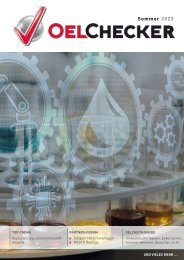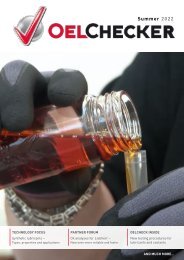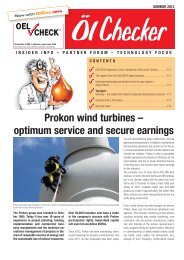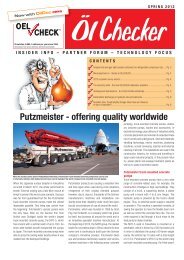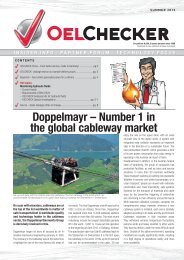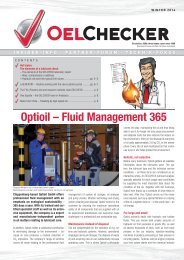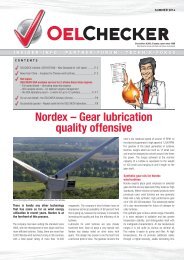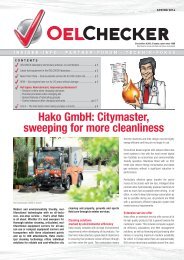OELCHECKER - Winter 2012
> OELCHECK China – Getting ready before the new laboratory opens > OELCHECK Laboratory – quicker and more accurate with a new particle counter > Hot Topics: The analysis of lubricating greases > Correct sampling > Most important analysis methods > Experience of our experienced tribologists > In demand – optimising online documentation of laboratory reports > and much more...
> OELCHECK China – Getting ready before the new laboratory opens
> OELCHECK Laboratory – quicker and more accurate with a new particle counter
> Hot Topics: The analysis of lubricating greases
> Correct sampling
> Most important analysis methods
> Experience of our experienced tribologists
> In demand – optimising online documentation of laboratory reports
> and much more...
Create successful ePaper yourself
Turn your PDF publications into a flip-book with our unique Google optimized e-Paper software.
Preparation for AES analysis<br />
AES – the base analysis for all<br />
After homogenisation, OELCHECK looks at 27<br />
elements from each grease sample that is sent in<br />
using the atomic emission spectroscopy (AES) by<br />
the Rotrode method. These provide information<br />
in mg/kg about wear, impurities, thickeners and<br />
additive levels in the sample.<br />
Wear metals: Iron, chromium, tin, copper, lead,<br />
nickel, aluminium, molybdenum and zinc as well<br />
as possible levels of vanadium, titanium, silver,<br />
antimony, manganese and tungsten.<br />
Impurities: Silicon, calcium, sodium, potassium,<br />
aluminium, cadmium, bismuth.<br />
Additives, thickener or soap levels: Lithium,<br />
magnesium, calcium, phosphorus, zinc, barium,<br />
silicon, aluminium, molybdenum and boron.<br />
AES information:<br />
• Increased iron and chromium values indicate<br />
that a rolling bearing has been subject to wear;<br />
copper, lead and tin show corrosion or abrasive<br />
wear from bearing cages.<br />
• Possible impurities, such as silicon (dust),<br />
calcium (lime) or hard water deposits help to<br />
identify the causes of wear.<br />
• Deviations between fresh and used grease<br />
in terms of the content and composition of the<br />
additive package or the thickener show that<br />
another grease is being used.<br />
PQ Index – searching for iron<br />
The PQ Index (Particle Quantifier Index) is specialised<br />
in determining magnetisable iron particles.<br />
Unlike AES, which cannot easily detect iron particles<br />
>5 µm, it records all the wear particles which<br />
are magnetisable, regardless of their size. The<br />
height of the PQ Index is then measured in conjunction<br />
with the AES iron content. As an index the<br />
PQ value is dimensionless.<br />
PQ Index information<br />
• An extreme PQ index (e.g. over 500) indicates,<br />
regardless of the AES iron values, that acute<br />
wear has taken place. Often there has been<br />
pitting or material fatigue.<br />
• If there is a high PQ level (e.g. over 200) and at<br />
the same time the AES indicates a low iron value<br />
(e.g. under 100), acute wear is occurring and causing<br />
relatively big wear particles.<br />
• An increased PQ index (e.g. over 100) in combination<br />
with a correspondingly high AES iron value is a<br />
sign of typical material fatigue, during which „normal“<br />
wear occurs.<br />
• A low PQ index (under 50 or O.K.) accompanied<br />
by a high AES iron value (e.g. over 100 mg/kg) is<br />
always a sign of corrosion and rust formation. Rust<br />
is barely magnetisable so produces a low PQ index.<br />
PQ index analysis FT-IR analysis Karl Fischer water analysis<br />
The most important analysis methods<br />
FT-IR – basic oil type and state<br />
The principle of FT-IR (Fourier Transform Infrared)<br />
spectroscopy is based on there being different<br />
molecules present in a lubricant which, because of<br />
their typical chemical structures, absorb infrared<br />
light to different degrees with certain wavelengths.<br />
Changes to the used lubricant can be compared to<br />
the fresh grease reference spectrum and depicted,<br />
calculated and interpreted as typical „peaks“ for<br />
certain „wave numbers“. In addition to identity<br />
controls, oxidation can also be proven with FR-IT<br />
spectroscopy, for instance. As they age, molecular<br />
compounds alter and absorb more infrared light<br />
than fresh grease. Through the process of Fourier<br />
transformation, these values can be read and the<br />
molecular vibrations represented in an FT-IR diagram.<br />
Depending on the molecular compounds, the<br />
peaks develop as corresponding wave numbers.<br />
Synthetic lubricants frequently contain ester-based<br />
components. Because of the oxygen molecules<br />
contained within them, they absorb infrared light in<br />
almost the same wavelength range as the double<br />
oxygen bonds which arise through oxidation. That<br />
is why oxidative changes to a synthetic oil cannot<br />
be calculated accurately using IR alone. The RULER<br />
test is needed to do this.<br />
FT-IR spectrum information<br />
• Through comparison with the deposited fresh<br />
grease spectra, the process provides quick and<br />
reliable information on whether greases have<br />
been mixed together or whether a completely<br />
different type of grease has been used.<br />
• The process can also determine whether the<br />
grease that has been examined contains mineral-oil-based<br />
base oil or synthetic base oil.<br />
• For mineral-oil-based base oil, the FT-IR determines<br />
whether oxidation has taken place<br />
because of a lack of re-lubrication or because of<br />
damage caused by high temperatures.<br />
• If a grease contains high-pressure additives, e.g.<br />
zinc phosphorus base, additive deterioration may<br />
be detected.<br />
• A fresh grease comparison can also prove<br />
whether there is too much water.<br />
Water analysis, Karl-Fischer titration<br />
Too much water in grease may cause corrosion<br />
and bearing damage. In places with high relative<br />
movement, cavitation can occur. If too much water<br />
is present or water penetrates continuously, relubrication<br />
must be done more frequently. If the<br />
grease cannot withstand the water it may become<br />
soft or watery and the quality will drop.<br />
The amount of water in a grease sample is calculated<br />
exactly using the Karl-Fischer method in ppm<br />
(mg/kg), the same method as for oil. To do this,<br />
water must be „driven out“ of the sample. With oil,<br />
the water from the sealed sample is steamed away<br />
by heating it to temperatures of up to 140 °C, but<br />
it is much harder to boil the water out of grease.<br />
In this case, the water must be extracted slowly at<br />
a temperature of 120 °C. The water is channelled<br />
into a titration vessel using a hollow needle and<br />
nitrogen. Here, an electrochemical reaction takes<br />
place with a special KF solution. Once the transition<br />
point of the titration curve has been reached, the<br />
exact water content can be stated.<br />
K.F. information Water analysis<br />
• If a grease contains too much water, it is important<br />
to track down the origin and to eliminate it.<br />
The Karl Fischer method provides quantitative information<br />
about water content. The elements investigated<br />
by the Atom Emissions Spectroscopy<br />
process help to distinguish between condensate<br />
and tap water.<br />
• If unlike the fresh grease sample the used<br />
grease sample is polluted with sodium, calcium,<br />
potassium or magnesium this points to „hard“<br />
water. It may have penetrated the grease during<br />
high-pressure cleaning. If these minerals are not<br />
present it may be „soft“ rain or condensed water.<br />
• If water has not been satisfactorily removed during<br />
the production of the grease, it may be found<br />
in fresh grease. An analysis of fresh and used<br />
grease clarifies this matter.<br />
Bleeding test - lubricating effectiveness<br />
of residual oil content<br />
The sponge-like structure of the thickener or soap<br />
used in grease holds the base oil firm and allows<br />
it to transfer slowly to the lubrication point. But if<br />
the oil flows too quickly and uncontrollably from the<br />
thickener structure, the grease „bleeds“ away. If<br />
the remaining thickener contains too little oil for the<br />
lubrication tasks, the remaining grease dries out. If<br />
the residual oil content of a grease falls too quickly,<br />
either the grease at hand is unsuitable or it must<br />
be reapplied more frequently or in larger quantities.<br />
Determining the residual oil content provides<br />
the necessary information to decide which. The<br />
test shows the percentage of base oil that the soap<br />
structure has lost over the course of six hours, at<br />
a temperature of 60 °C. The residual oil content<br />
of used grease should then be compared with the<br />
fresh grease sample.<br />
5




